How to Choose Curtains – Secret Guide by Interior Designers
10 Mins Read
January 17th, 2024
Curtains are lightweight materials hanging in a window opening, and draperies are heavy fabrics that do the exact same role. Although they might seem fairly simple to choose and install based on the wall colors of the home, there’s actually a lot of precision, forethought, planning, and decorating that goes into determining the right fit of curtains and drapes for your client’s home.
Depending on where the curtain is hung, how long it runs, the thickness it has and so many more factors, the level of lighting, ambiance, and mood are highly influenced. You don’t want your client to fall asleep in a bright room, and wake up in a dark one, or feel gloomy working in a dark home office or kitchen.
Since almost 2/3rds of the room’s light comes from the 1/3rd top of the window, getting proper window treatment for your client’s home is essential in the short and long run. Walk with us and we’ll explore how to choose curtains, what you can expect, and how you need to pick the right ones for the right rooms, be it your living room, bedroom, kitchen, or nursery.
Jump ahead to:
The type and place your client wants to hang the curtains determines the properties the curtains will have, and it’s important to reverse engineer the process and start from what goals your client wants to meet.
The following are a few questions that can narrow down their choices and help you arrive at a suitable shortlist of options:
Read also – Top 5 DIY Interior Design Software to Design Your Next Design Project
There are multiple types of curtains, depending on the materials, finishes, properties, and lining they have.

Linings stabilize the fabric keep sunlight from fading the fabric, and control light entry. It offers thermal insulation which protects from severe temperatures and sound insulation that keeps street noise away.
They have an extra layer of material between the lining and the main fabric. They are the thickest and heaviest curtain options to exist. Bedrooms would do well with interlined curtains. Another popular curtain material is the blackout curtain, which keeps the room dark and aids in quality sleep in the bedroom.
They have a single layer of fabric, look less formal and are absolutely budget-friendly. If your client only maintains curtains rarely, these curtains are perfect for them. The caveat is they don’t block out light, and the light is still going to enter the room. Unlined curtains are perfect for kitchens.
The fabric and lining are joined together to form a tube-like structure, hence the name. They are best for smaller curtains. Please note that the curtain movement will be restricted for this type of curtain. If used as a living room curtain, it would be hard to move them to make way for bright light.
Lightweight, translucent, extra wide curtains that work well for wide windows.
Read also – How to Create the Best Architect Portfolio in 2024
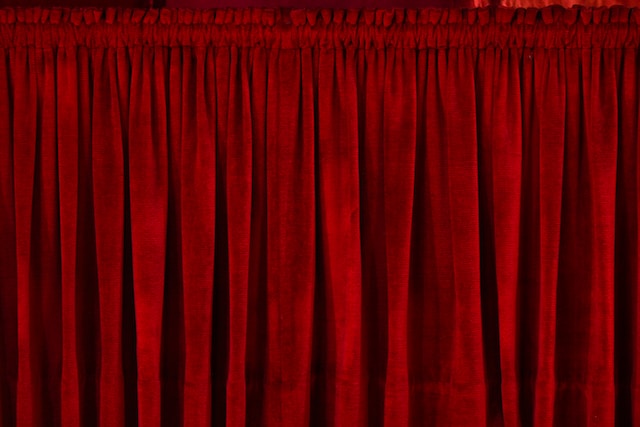


Curtain headings are the top portion of the curtain where they meet the rod or pole. How they are hung decides how easy they are to move.
The curtain fabric is used to form loops at the curtain heading and hung on a pole. It gives a modern and sleek look. But opening and closing the curtains are a major hassle, and there’s no smooth run.
The curtain heading looks as though a bunch of slim pencils are stacked together. The curtain fabric’s folds huddle at the curtain heading together to give a pleated look. It exudes a classic, refined look and works exceedingly well with any kind of fabric.
The curtain has defined eyelets, or small holes at the top, through which the curtain pole is fed. This type of curtain heading looks dashing and is trending right now.
The curtain heading is slightly folded inwards at the top and stitched together to create a channel. The curtain is slid underneath. In places where your client won’t ever move their curtains, pocket curtain heading is preferable.
With an uneven shape at the top, they radiate a charming, informal, and contemporary aesthetic to the home.
Read also – 34 Beautiful Modern Kitchen Design Ideas for 2024
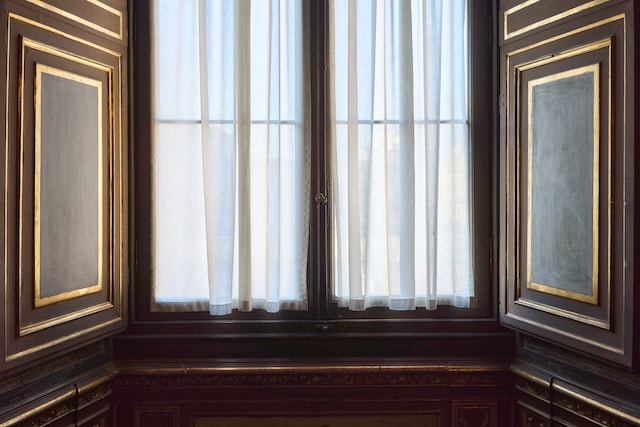


Based on how far the curtain is from the floor, they are categorized into 4 types.
These are curtains hanging half an inch above the window sill.
These curtains hang 2-4 inches below the window sill.
They stop ½ an inch above the floor.
They are floor-length curtains extending 2-8 inches beyond the floor length to make way for a grand, palatial look.
Read also – 9 Best Contemporary Interior Design Ideas For Your Home
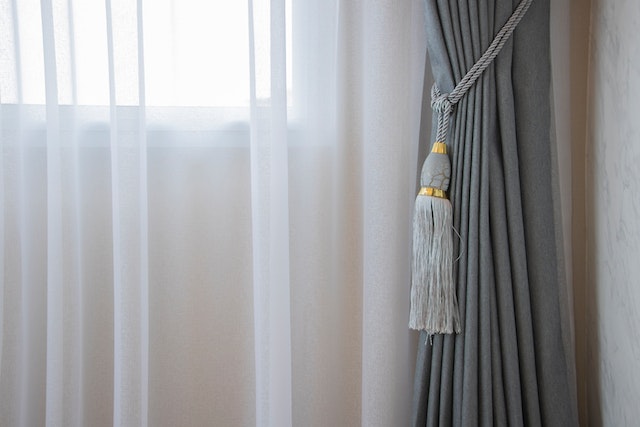


Before we move on to the curtains, please note that the hanging pole or track must be 6 inches above the window and extend 6-8 inches on either side of the window.
A sheer fabric curtain with an ombre effect, to put a bright spin on the traditional window treatment.
Directly suspended from the ceiling, can be closed or opened. They offer a secluded, dreamy space for solo activities, reading, writing, and sleeping for children predominantly. Hanging play tents can be installed in the nursery or the children’s room and adorned with bright colors, textures, and patterns.
Any curtain with a tieback (a tie, or a thick ribbon) to hold it away from the window, and maximize the entry of light into any space, especially the living room. Traditional buckram-lined tieback looks professional and tailored.
If your client doesn’t like a fussy window treatment and is looking for a contemporary, masculine look, this is a great choice. The tubelike folds require minimum fabric and look chic in any setting. If you have a metal pole, you can match the curtain’s finish to the eyelet rings.
Read also – How to Design and Decorate a Dining Room?



If your client wants a refreshing, remarkable alternative to curtains, shades are a good option to consider. They use less fabric and yet create stunning effects. When trying out shades, ensure you guide your client through raising and lowering shades at different angles and assess their aesthetics and functionality at each angle.
The shade comes with a chain to raise and lower it. It’s primarily used for bathrooms and kitchens. These shades provide a level of privacy to a room and also heighten the cozy ambiance with a chic and contemporary look.
They automatically roll a fabric around the pole and the fabric stacks neatly as the shade is opened.
A panel of fabric rolled up and unrolled by tightening and loosening a pair of ties, that’s a tie shade. Contrasting ribbon ties and lining glam up the shade, which make for a stunning visual appeal in the living room.
It gathers only into soft folds when it is raised. It serves as an attractive focal point to the room it is in and is more casual in tone. No rods at the bottom.
Read also – 28 Best Wall Decor Ideas To Decorate Your Blank Wall
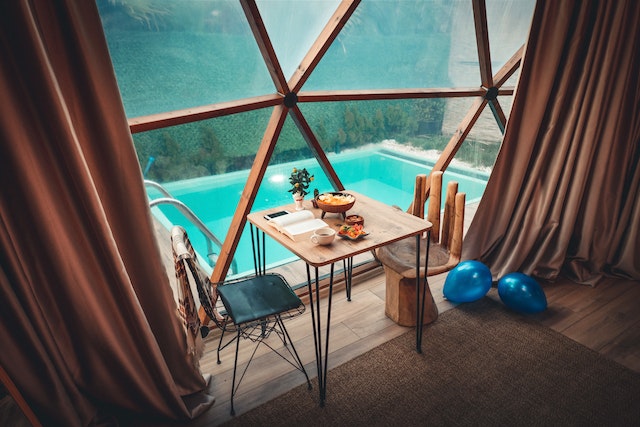


They are window treatments that are constructed with heavy fabrics, keeping in mind the palatial, royal look the thick, block drapes display. They hang straight down from the ceiling, almost like the curtain.
It’s a drape that is closed at the curtain heading and at the end but is partially open in the middle to form a diamond shape. They are mostly lined have scalloped edges, and are held open by tassels, ties, or ribbons.
They are simple, long curtains that accrue wide folds at the top, near the curtain heading and suspend freely from the top all the way to the bottom. Swags are suitable for wide windows.
Super-thick, uniform, mildly patterned drape that is used mainly for decorative purposes, and blocks light.
Read also – What is 3D drawing and how is it transforming interior design?
There are other interesting materials and types of curtains you can experiment with before finalizing the right fabric for each room if your client wants to add an extraordinary flair to their room decor.
Blinds are simple to use, easy to clean, and of controllable height. They are found in both vertical and horizontal orientations, as rollers, and are commonly made from plastic, wood, faux wood, fabric, or metal.
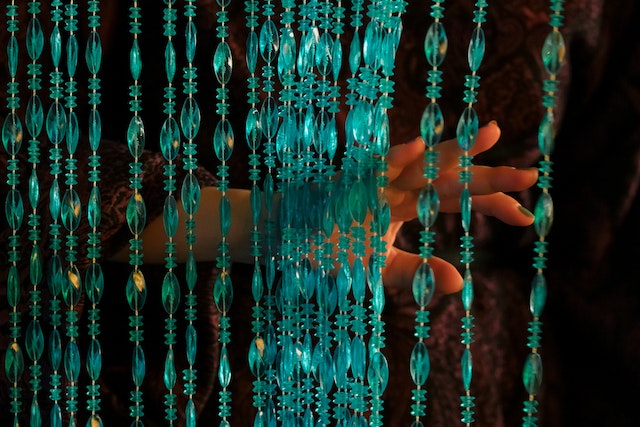


Beads strung together to form a sequence that obscures vision beyond it. They show a free, contemporary feel with unlimited options. The beads can be acrylic, shells, bamboo, gemstones, glass beads, strong, and mirrors. They repel moisture and can be conveniently used in bathrooms with no fear of being dampened.
Voiles are easily hung on the curtain pole. They are lightweight, easily washed, are of very low maintenance, and bring about a breath of freshness to the room with their artistic quality, and elegance.
Read also – How to Draw a Floor Plan & Top Mistakes to Avoid
If you’re confused about what materials to select your client’s curtain from, here’s a set of commonly used fabrics for curtains, that can quicken your decision-making process.
| Material | Properties |
| Calico | Firm cotton curtains are user-friendly and can be easily bleached or unbleached. |
| Muslin | Lightweight, and white in color. Available in patterns as well. |
| Linen | Natural fiber, slightly heavyweight, and linen curtains come in neutral colors. |
| Jacquard | Comes in swirling patterns and foliage |
| Velvet | Soft to touch, but velvet can be one of the heavier fabrics to handle. |
| Chintz | High-quality cotton fabric with a breathable layer. |
| Gingham | Lightweight fabric often comes with small checkered patterns. |
With plenty of options available in every category, and one better than the other in many ways, showcasing all the options to your client and getting them to pick one is nearly impossible. You can do two things to ensure you select the right curtains for your client. Firstly, get to know them as a person, take a look at their wardrobe, what materials comfort them, what materials amaze them, and start from there. When you pose questions about their preferences and make observations about their liking in general, you will be able to ascertain the fabrics or types of curtains they’re drawn towards, present samples and seek feedback.
Secondly, and this is the best bet– you can use advanced interior design tools like Foyr Neo to conceptualize how their home will look, where window curtains will be designed, how light enters during different parts of the day, and how best to control overheating and glare at home.
Curtains not only control natural light from coming in, they also obscure your indoors to your neighbors in the evening, after sundown. So the materials, finishes, and colors you choose need to go well with natural and artificial illumination.
With Foyr Neo, you can’t make a mistake. You can draw up clearer-than-life floor plans, figure out light entry points, sight lines, and materials that would do well with the color palette, texture, and mood, select from 50,000+ 3D elements, follow AI-guided lighting and finishing touches and show your client multiple combinations of curtains and impress them in no time.
If you want to shorten your design process and also give the highest satisfaction to your client, Foyr Neo is the way to go.
Sign up for our 14-day free trial today, and start living your dream future.
Measure the height from the curtain rod to the floor for length and consider 1.5 to 2 times the window width for width, ensuring that curtains extend beyond the window frame for an elegant look.
Custom-made curtains offer precise sizing, fabric choices, and unique designs to align with the home interior, while ready-made curtains are more cost-effective and convenient.
Install curtain rods or tracks close to the ceiling and extend the curtains well beyond the window’s width to create a sense of height and width.
Follow the manufacturer’s care instructions and regularly vacuum or dust curtains. Dry clean or wash them as recommended to maintain their appearance and durability.
Using Foyr Neo is as easy as 1, 2, 3. First, upload a floor plan or create one from scratch. Then drag and drop from over 60K 3D models to fill your rooms. Lastly, just set the shot and let the AI create stunning 4K renders for you in less than 10 minutes.
Start your 14-day free trial

No Credit Card Or Download Required


Specially built for Interior Designers



